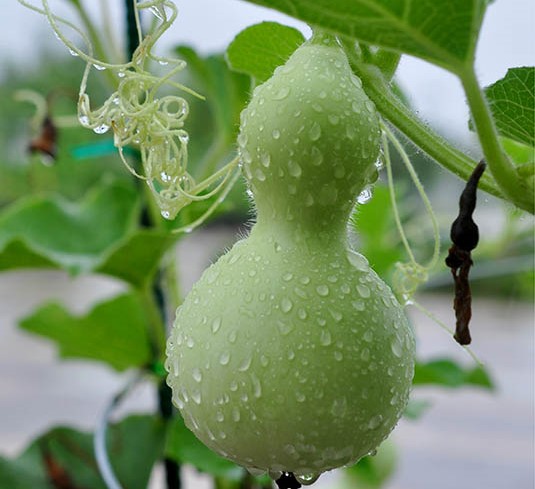Lagenaria siceraria

|
|
Lagenaria siceraria Common Names: Bottle Gourd, Calabash, White-Flowered
Gourd, Opo Squash Scientific
Classification Kingdom: Plantae Clade: Tracheophytes Clade: Angiosperms Clade: Eudicots Clade: Rosids Order: Cucurbitales Family: Cucurbitaceae Genus: Lagenaria Species: L. siceraria Synonyms: Cucumis lagenaria (L.) Dumort., Cucumis mairei H.Lév., Cucurbita ciceraria Molina, Cucurbita idololatrica Willd., Cucurbita lagenaria L., Cucurbita leucantha Duchesne, Cucurbita longa W.M.Fletcher, Cucurbita pyriformis M.Roem., Cucurbita siceraria Molina, Cucurbita vittata Blume Morphological Description Lagenaria siceraria is a vigorous annual vine, sprawling up to 5–15 m with
tendrils, thriving in tropical and subtropical climates. Its key features
include: · Stem: Herbaceous, ribbed, pubescent, climbing or trailing with
bifid tendrils. · Leaves: Broad, ovate to reniform, 10–40 cm long and wide,
soft-hairy, with a musky odor when crushed. · Flowers: White, 5–10 cm across, unisexual, nocturnal, with five
petals; male flowers on long peduncles, female flowers shorter with an inferior
ovary. · Fruit: Highly variable, 10 cm to over 1 m long, light green and
smooth when young, hardening to yellow-brown when mature; shapes include
globular, bottle-like, or serpentine (Jeffrey, 1967). The fruit’s
versatility—edible when young, durable when dried—underpins its cultural
significance (Decker-Walters et al., 2004). Distribution and Habitat Lagenaria siceraria likely originated in Africa, with wild populations in
Zimbabwe, and spread globally via human migration and ocean dispersal: · Africa: Senegal to South Africa, Ethiopia to Zimbabwe (wild and
cultivated). · Asia: India, Thailand, Philippines, Japan. · Americas: Mexico, Peru, introduced pre-Columbian. It thrives in warm
climates (soil >70°F), on well-drained, loamy soils (pH 6.0–7.0), preferring
full sun with afternoon shade, at altitudes from sea level to 2,000 m (Fern,
2024). Ethnopharmacology Lagenaria siceraria, commonly known as bottle gourd, has been
traditionally utilized for its medicinal properties across various cultures.
The fruit is recognized for its cardioprotective, diuretic, aphrodisiac, and
general tonic benefits. Additionally, the fruit pulp exhibits cooling,
diuretic, antibilious, and pectoral properties, and when boiled in oil, it is
used to treat rheumatism and insomnia. Phytochemical analyses have identified
compounds such as sterols, terpenoids, flavonoids, and saponins in the plant,
which may contribute to its therapeutic effects. Furthermore, the fruit has
been reported to possess antihyperglycemic and antihyperlipidemic properties,
indicating its potential in managing diabetes and related conditions. These
diverse medicinal applications underscore the significance of Lagenaria siceraria in traditional
medicine and highlight its potential for further pharmacological research. · Anti-inflammatory/Analgesic: In India, fruit pulp treats joint pain. · Antioxidant: Leaf decoctions in Nigeria combat oxidative stress. Mayakrishnan
et al. (2010) assayed free radical scavenging activity of the L. siceraria (Molina) fruit extract by
using α,α-diphenyl-β-picrylhydrazyl (DPPH), 2,20-azinobis 3-ethyl
benzothiazoline-6-sulfonate (ABTS), FRAP, reducing power, chelating ability and
β-carotene bleaching assay. The
IC50 values of DPPH and ABTS radical-scavenging activity was found to be 1.95
mg/mL and 19 mg/mL, respectively. In ferrous chelation assay, the percentage of
inhibition was found to be 89.21%. The reducing power of ethanolic extract of
L. siceraria (Molina) fruit was 0.068 at 1 mg/mL and increased to 0.192 at 5
mg/mL. The β-carotene linoleate bleaching assay was 46.7% at 5 mg/mL and
antioxidant activity using FRAP at 0.305 for 1 mg/mL to 0.969 for 5 mg/mL. · Anti-diabetic: Fruit juice in Pakistan manages blood sugar. Teugwa et al.
(2013) showed seed extracts (300 mg/kg) lowered glucose in alloxan-induced
diabetic rats by 40%, via globulin proteins. · Cardioprotective: Pulp in Ghana protects heart health.
Upaganlawar et al. (2011) evaluate the
cardioprotective effects of Lagenaria
siceraria fruit juice in isoproterenol-induced myocardial infarction. Rats
injected with isoproterenol (200 mg/kg, s.c.) showed a significant increase in
the levels of serum uric acid, tissue Na++ and Ca++ ions and membrane-bound
Ca+2-ATPase activity. A significant decrease in the levels of serum protein,
tissue K+ ion, vitamin E level, and the activities of Na+/K+-ATPase and
mg+2-ATPase was observed. Isoproterenol injected rats also showed a significant
increase in the intensity of lactate dehydrogenase isoenzyme and
histopathologic alterations in the heart. Treatment with L. siceraria fruit
juice (400 mg/kg/day, p.o.) for 30 days and administration of isoproterenol on
29th and 30th days showed a protective effect on altered biochemical and
histopathologic changes. These findings indicate the cardioprotective effect of
L. siceraria fruit juice in isoproterenol-induced myocardial infarction in
rats. · Hepatoprotective: Seed oil in Egypt supports liver function..
Almohmadi, et al. (2024) noted that In CCl4-treated rats, there was a
significant increase in serum liver marker enzyme activity (ALP, AST, and ALT)
along with a significant elevation (p < 0.05) in total bilirubin, indirect
bilirubin, and direct bilirubin compared to the control rats. However, all
these parameters decreased in the CCl4+ Silymarin and CCl4+ Lagenaria siceraria seed oil (LSS) groups compared to
CCl4-treated rats. There was a significant decline in total protein level and
serum albumin in all experimental groups compared to the control, while
globulin levels significantly increased in all experimental groups. There was a
significant (p < 0.05) reduction in the level of GSH and catalase, with an
increase in MDA level in CCl4 rats compared to other rats. Histopathological
investigation of the LSS-treated group showed a hepatoprotective effect against
CCl4. Phytochemicals include
cucurbitacins, flavonoids, saponins, and triterpenoids (Saeed et al., 2022). ⚠ Toxicity Profile: Bitter fruits, high in cucurbitacins, can cause
severe gastrointestinal distress or death if consumed raw or juiced. Cases
include fatalities in diabetics from bitter juice (Saeed et al., 2022). Additional Uses · Culinary: Young fruits cooked as vegetables in Asia and Africa (Decker-Walters
et al., 2004). · Cultural: Dried gourds as containers, instruments (e.g., kora), or
helmets in Nigeria (Price, 1982). · Ecological: Vines stabilize soil in agroecosystems (Fern, 2024). References
External Links More Pictures |
|
| Compounds of Lagenaria siceraria | |
| References |